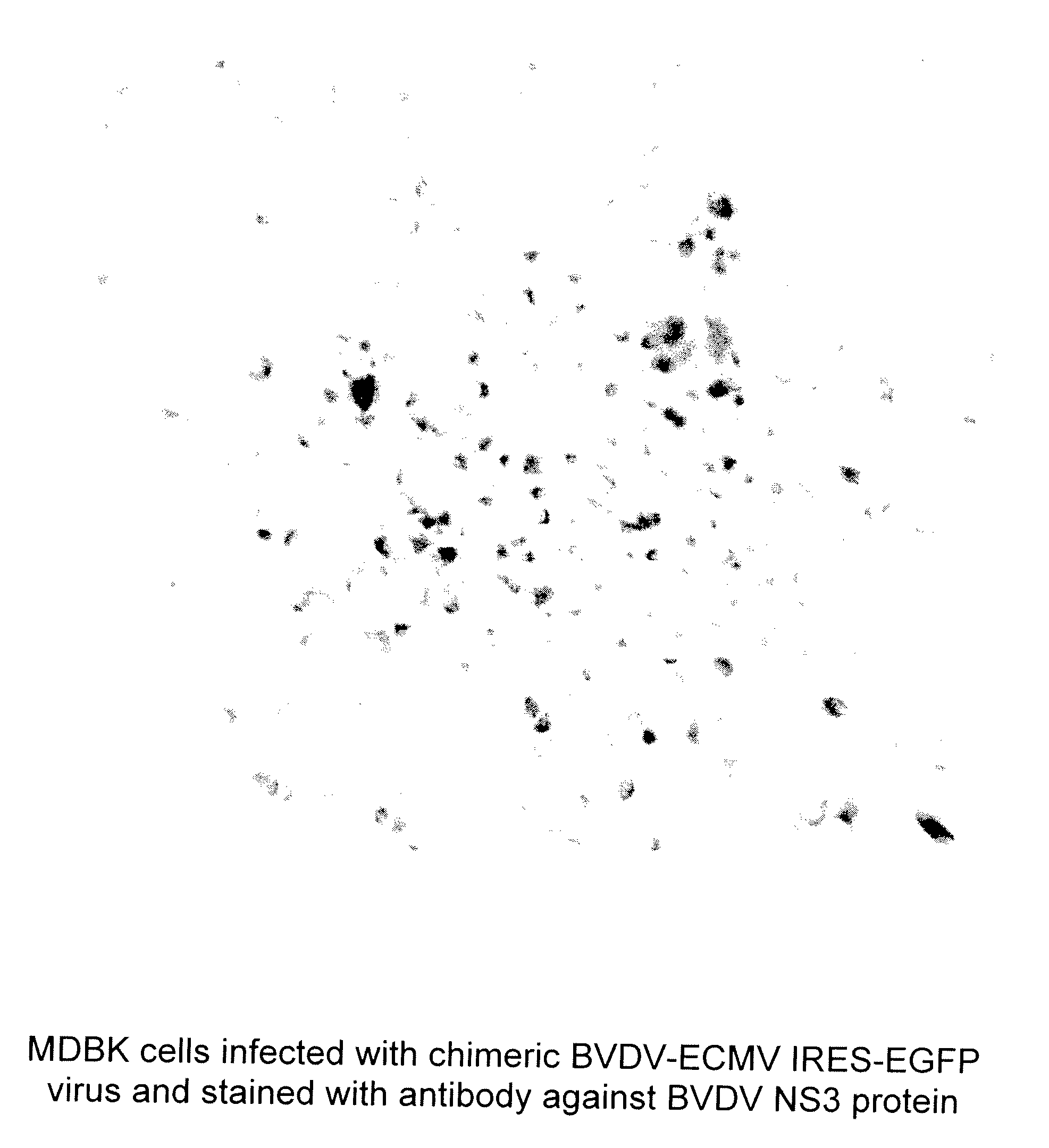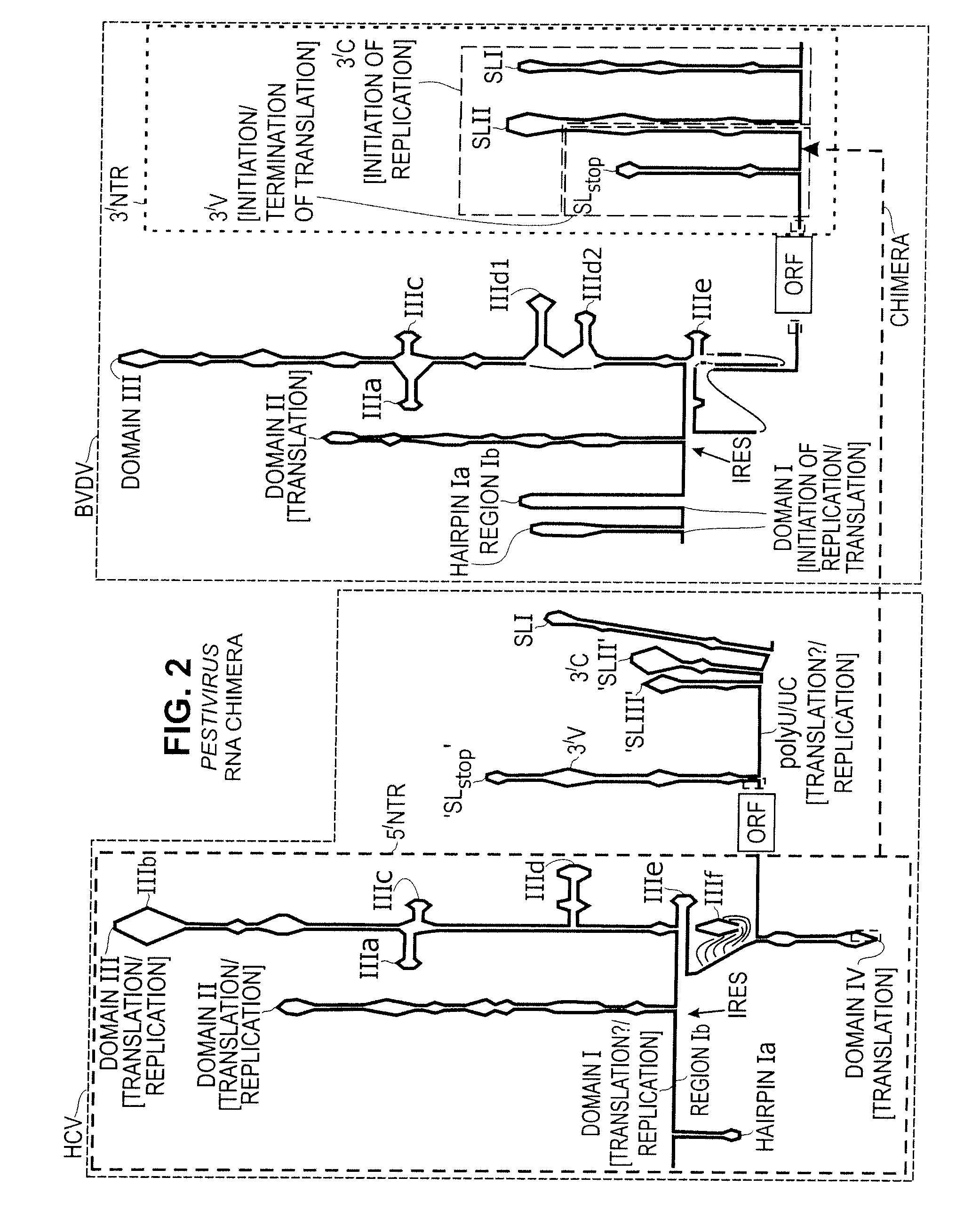Chimeric pestivirus with insertion in 3' nontranslated region (3' NTR) with stable replication and rnase resistance
a pestivirus and non-translated region technology, applied in the field of chimeric pestivirus with, can solve the problems of presenting additional technical difficulties in analytical rna assays, inability to obtain natural sources of materials, and inability to use materials potentially infectious to humans
- Summary
- Abstract
- Description
- Claims
- Application Information
AI Technical Summary
Problems solved by technology
Method used
Image
Examples
example 1
Construction of BVDV-non-CP7 cDNA and Generation of Infectious Non-Cytopathic Viral RNA
[0075]A modified cDNA of BVDV (type-1) strain CP7 was generated as a starting material for all subsequent procedures (Becher et al., 2000 J. Virol. 74: 7884-7894). The modification was performed such that the CP7 insert (Tautz et al., J Virol. 1996 November; 70(11):7851-8) was removed to create a cDNA containing plasmid that encoded a BVDV “non-CP7” RNA biotype (M. Behrens, unpublished data). A similar construct was published earlier by Makoschey et al., (Vaccine, 2004, Sep. 3; 22(25-26):3285-94.) The complete sequence of the cDNA for the BVDV-non-CP7 is given as SEQ ID NO: 1.
[0076]The plasmid encoding the BVDV-non-CP7 cDNA was linearized by restriction digestion with the restriction endonuclease SmaI. In vitro transcripts were generated by run-off transcription using SP6 RNA polymerase. The viral RNA was generated by in vitro transcription using SP6 RNA polymerase. The in vitro generated BVDV-no...
example 2
Generation of Chimeric BVDV-non-CP7 cDNAs
[0077]The plasmid including the BVDV-non-CP7 cDNA (SEQ ID NO: 1) was then used to introduce the HCV 5′NTR sequence (HCV Con1 cDNA; Lohmann et al., 1999) within the BVDV 3′NTR to obtain a functional chimeric viral sequence (BVDV-non-CP7-HCV 5′NTR).
[0078]For that purpose, a synthetic DNA fragment was generated commercially. This DNA fragment corresponded to the Cla1 (initiating at pos. 11047 of the BVDV-non-CP7 cDNA sequence) / SmaI (initiating at pos.12264 of BVDV-non-CP7 cDNA sequence) fragment of the BVDV-non-CP7 cDNA (SEQ ID NO:1), but also included an HCV 5′NTR insert (Con 1 subtype 1b isolate; Lohmann et al., 1999, Science. July 2: 285 (5424): 110-3) flanked by two restriction sites (SnaBI and PacI) and an additional TAA trinucleotide. The cDNA sequence of the HCV 5′NTR is given in SEQ ID NO: 2. This heterologous insert was positioned such that in corresponding RNA transcripts it was located between the UGApos.cons. box and the SLIT stem-lo...
example 3
Stability of the cDNA Plasmid Constructs of the Newly-Generated Pestivirus BVDV Chimeras
[0083]Several individually isolated cDNA plasmids encoding either BVDV-non-CP7 (:: 1), the BVDV-non-CP7+cloning site chimera (SEQ ID NO: 4), or the BVDV-non-CP7-HCV 5′NTR chimera (SEQ ID NO: 3) were grown in E. coli. The plasmids were prepared using standard procedures and the authenticity of the inserts was verified by DNA sequencing. The overall stabilities of the plasmids through several passages in E. coli were verified by performing restriction analysis using multiple restriction enzymes and sequencing.
PUM
| Property | Measurement | Unit |
|---|---|---|
| length | aaaaa | aaaaa |
| temperatures | aaaaa | aaaaa |
| temperatures | aaaaa | aaaaa |
Abstract
Description
Claims
Application Information
 Login to View More
Login to View More - R&D
- Intellectual Property
- Life Sciences
- Materials
- Tech Scout
- Unparalleled Data Quality
- Higher Quality Content
- 60% Fewer Hallucinations
Browse by: Latest US Patents, China's latest patents, Technical Efficacy Thesaurus, Application Domain, Technology Topic, Popular Technical Reports.
© 2025 PatSnap. All rights reserved.Legal|Privacy policy|Modern Slavery Act Transparency Statement|Sitemap|About US| Contact US: help@patsnap.com



